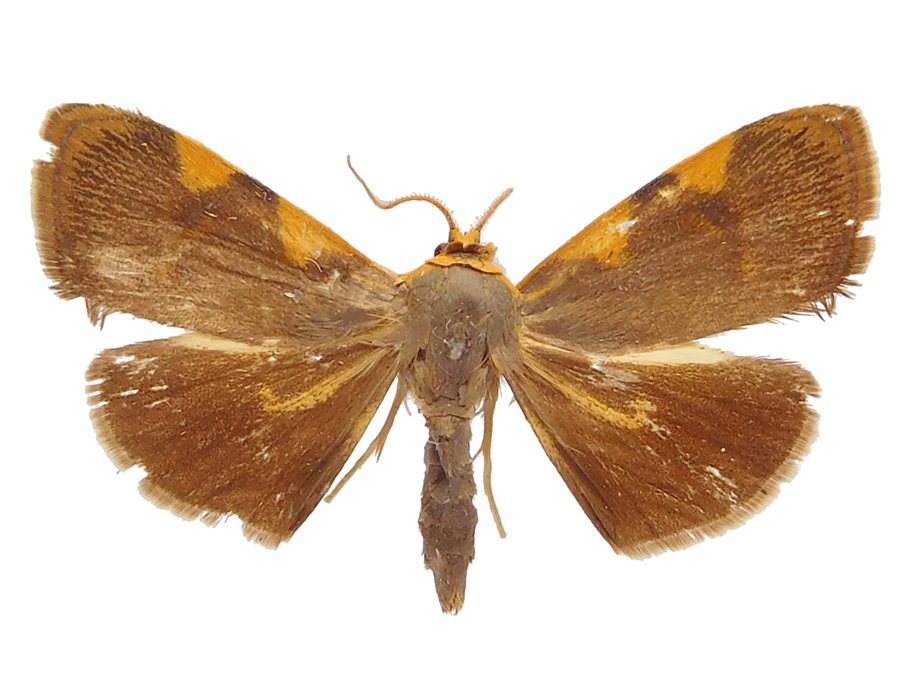Abstract
The open-holed trapdoor spiders of the genus Teyl Main, 1975 from the Pilbara bioregion of Western Australia are investigated. A single endemic species from the southern Pilbara, T. heuretes sp. nov., is newly described, representing the northern-most occurrence of the genus in Australia. Legacy molecular data for Australian Nemesiidae, along with newly generated sequences for all described species of Teyl known from Western Australia, are analysed using Maximum Likelihood methods, providing molecular data for T. heuretes and an expanded phylogenetic assessment of the genus.
References
Brown, R.W. (1956) Composition of Scientific Words. Revised Edition. Smithsonian Institution Press, Washington, D.C., 812 pp.
Castalanelli, M.A., Huey, J.A., Hillyer, M.J. & Harvey, M.S. (2017) Molecular and morphological evidence for a new genus of small trapdoor spiders from arid Western Australia (Araneae: Mygalomorphae: Nemesiidae: Anaminae). Invertebrate Systematics, 31, 492–505.
https://doi.org/10.1071/IS16061
Castalanelli, M.A., Teale, R., Rix, M.G., Kennington, W.J. & Harvey, M.S. (2014) Barcoding of mygalomorph spiders (Araneae: Mygalomorphae) in the Pilbara bioregion of Western Australia reveals a highly diverse biota. Invertebrate Systematics, 28, 375–385.
https://doi.org/10.1071/IS13058
Castresana, J. (2000) Selection of conserved blocks from multiple alignments for their use in phylogenetic analysis. Molecular Biology and Evolution, 17, 540–552.
https://doi.org/10.1093/oxfordjournals.molbev.a026334
de Queiroz, K. (2007) Species concepts and species delimitation. Systematic Biology, 56, 879–886.
https://doi.org/10.1080/10635150701701083
Durrant, B.J., Harvey, M.S., Framenau, V.W., Ott, R. & Waldock, J.M. (2010) Patterns in the composition of ground-dwelling spider communities in the Pilbara bioregion, Western Australia. Records of the Western Australian Museum, 78 (Supplement), 185–204.
https://doi.org/10.18195/issn.0313-122x.78(1).2010.185-204
Harvey, M.S., Hillyer, M.J., Main, B.Y., Moulds, T.A., Raven, R.J., Rix, M.G., Vink, C.J. & Huey, J.A. (2018) Phylogenetic relationships of the Australasian open-holed trapdoor spiders (Araneae: Mygalomorphae: Nemesiidae: Anaminae): multi-locus molecular analyses resolve the generic classification of a highly diverse fauna. Zoological Journal of the Linnean Society, 184, 407–452.
https://doi.org/10.1093/zoolinnean/zlx111
Harvey, M.S., Rix, M.G., Framenau, V.W., Hamilton, Z.R., Johnson, M.S., Teale, R.J., Humphreys, G. & Humphreys, W.F. (2011) Protecting the innocent: studying short-range endemic taxa enhances conservation outcomes. Invertebrate Systematics, 25, 1–10.
https://doi.org/10.1071/IS11011
Huey, J.A., Hillyer, M.J. & Harvey, M.S. (2019) Phylogenetic relationships and biogeographic history of the Australian trapdoor spider genus Conothele (Araneae: Mygalomorphae: Halonoproctidae): diversification into arid habitats in an otherwise tropical radiation. Invertebrate Systematics, 33, 628–643.
https://doi.org/10.1071/IS18078
Humphreys, W.F. (2008) Rising from Down Under: developments in subterranean biodiversity in Australia from a groundwater fauna perspective. Invertebrate Systematics, 22, 85–101.
https://doi.org/10.1071/IS07016
Katoh, K. & Standley, D.M. (2013) MAFFT multiple sequence alignment software version 7: improvements in performance and usability. Molecular Biology and Evolution, 30, 772–780.
https://doi.org/10.1093/molbev/mst010
Koch, L. (1873) Die Arachniden Australiens, Nach der Natur Beschrieben und Abgebildet. Bauer & Raspe, Nürnberg, 718 pp.
Lanfear, R., Calcott, B., Ho, S.Y. & Guindon, S. (2012) PartitionFinder: combined selection of partitioning schemes and substitution models for phylogenetic analyses. Molecular Biology and Evolution, 29, 1695–1701.
https://doi.org/10.1093/molbev/mss020
Lanfear, R., Calcott, B., Kainer, D., Mayer, C. & Stamatakis, A. (2014) Selecting optimal partitioning schemes for phylogenomic datasets. BMC Evolutionary Biology, 14, 82.
https://doi.org/10.1186/1471-2148-14-82
Main, B.Y. (1975) The citrine spider: a new genus of trapdoor spider (Mygalomorphae: Dipluridae). The Western Australian Naturalist, 13, 73–78.
Main, B.Y. (1982) Adaptations to arid habitats by mygalomorph spiders. In: Barker, W.R. & Greenslade, P.J.M. (Eds.), Evolution of the Flora and Fauna of Arid Australia. Peacock Publications, Frewville, Adelaide, pp. 273–283.
Main, B.Y. (1983) Further studies on the systematics of Australian Diplurinae (Chelicerata: Mygalomorphae: Dipluridae): two new genera from south western Australia. Journal of Natural History, 15, 923–949.
https://doi.org/10.1080/00222938300770731
Main, B.Y. (1985) Further studies on Australian Diplurinae: a review of the genera of the Teylini (Araneae: Mygalomorphae: Dipluridae). Australian Journal of Zoology, 33, 743–759.
https://doi.org/10.1071/ZO9850743
Main, B.Y. (1993) From flood avoidance to foraging: adaptive shifts in trapdoor spider behaviour. Memoirs of the Queensland Museum, 33, 599–606.
Main, B.Y. (2004) Biosystematics of Australian mygalomorph spiders: descriptions of three new species of Teyl from Victoria (Araneae: Nemesiidae). Memoirs of Museum Victoria, 61, 47–55.
https://doi.org/10.24199/j.mmv.2004.61.3
Pepper, M., Doughty, P. & Keogh, J.S. (2013) Geodiversity and endemism in the iconic Australian Pilbara region: a review of landscape evolution and biotic response in an ancient refugium. Journal of Biogeography, 40, 1225–1239.
https://doi.org/10.1111/jbi.12080
Raven, R.J. (1984) A new diplurid genus from eastern Australia and a related Aname species (Diplurinae: Dipluridae: Araneae). Australian Journal of Zoology Supplementary Series, 96, 1–51.
https://doi.org/10.1071/AJZS096
Raven, R.J. (1985) The spider infraorder Mygalomorphae (Araneae): cladistics and systematics. Bulletin of the American Museum of Natural History, 182, 1–180.
Rix, M.G., Raven, R.J., Austin, A.D., Cooper, S.J.B. & Harvey, M.S. (2018a) Systematics of the spiny trapdoor spider genus Bungulla (Mygalomorphae: Idiopidae): revealing a remarkable radiation of mygalomorph spiders from the Western Australian arid zone. Journal of Arachnology, 46, 249–344.
https://doi.org/10.1636/JoA-S-17-057.1
Rix, M.G., Raven, R.J. & Harvey, M.S. (2018b) Systematics of the giant spiny trapdoor spiders of the genus Gaius Rainbow (Mygalomorphae: Idiopidae: Aganippini): documenting an iconic lineage of the Western Australian inland arid zone. Journal of Arachnology, 46, 438–472.
https://doi.org/10.1636/JoA-S-17-079.1
Rix, M.G., Wilson, J.D. & Harvey, M.S. (2019) A revision of the white-headed spiny trapdoor spiders of the genus Euoplos (Mygalomorphae: Idiopidae: Arbanitinae): a remarkable lineage of rare mygalomorph spiders from the south-western Australian biodiversity hotspot. Journal of Arachnology, 47, 63–76.
https://doi.org/10.1636/0161-8202-47.1.63
Simon, E. (1889) Arachnides. In: Voyage de M. E. Simon au Venezuela (décembre 1887–avril 1888). 4e Mémoire. Annales de la Société Entomologique de France, Series 6, 9, 169–220.
Stamatakis, A. (2006) RAxML-VI-HPC: maximum likelihood-based phylogenetic analyses with thousands of taxa and mixed models. Bioinformatics, 22, 2688–2690.
https://doi.org/10.1093/bioinformatics/btl446
Talavera, G. & Castresana, J. (2007) Improvement of phylogenies after removing divergent and ambiguously aligned blocks from protein sequence alignments. Systematic Biology, 56, 564–577.
https://doi.org/10.1080/10635150701472164
Western Australian Government Gazette (2018) Wildlife Conservation (Specially Protected Fauna) Notice 2018. 11 September 2018. Available from: https://www.dpaw.wa.gov.au/images/documents/plants-animals/threatened-species/Listings/fauna_notice.pdf (accessed 1 April 2019)

